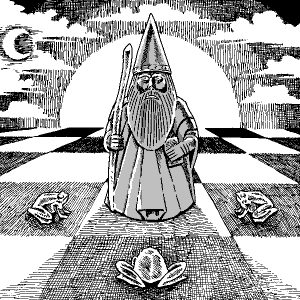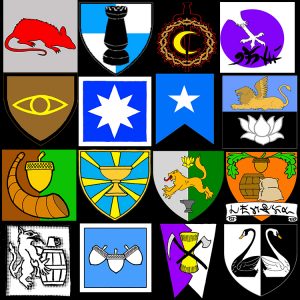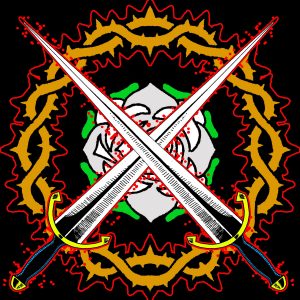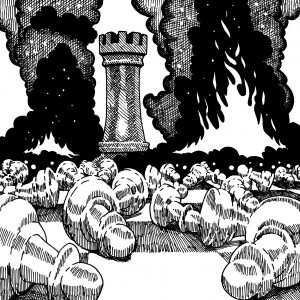The siege-lines stand expectantly the earthworks finished and the bulwarks fully manned. The walls of the small stone fortress stand tall against them though surrounded by the enemy’s vastly superior force. For now all there is is time to wait, to wait for a breach in the walls or main gates should the enemy sappers be successful or for those within to starve if her constable were ill prepared. Suddenly without warning several fireballs streak from between the crenelations at the top of the curtain walls blasting the carefully built lines into a confused screaming mass of rubble and fire. The castle’s wizard has only just begun.
Wizards, or more generically mages, are another major issue on the fantasy battlefield to take into account when thinking about mass combat in RPGs. Since the early days of fantasy Wargaming, wizards have been included as valuable and powerful combat units though mainly as artillery pieces dressed in robes. As roleplaying-games advanced so did the magical powers of the wizard making them very powerful units on the battlefield and in support roles. They have always been a feature of the fantasy arena of war. However, the popular fantasy archetype has appeared the antithesis of this.
Popularly wizards (mages in general) in archetypal terms appear as very old men with long beards or young boys or girls that are as skilled as their rank of apprentice would imply. However, a mage at their peak of physical ability, say late teens to early 60’s maybe older depending on the setting, would actively seek out powers to align with often simply to advance their material needs. After all, magic is often an expensive endeavor even though you may be practicing it for purely personal reasons. In times of war, a mage might seek out or make overtures to a political power also out of selfish aims. In addition, serving a powerful leader may be the fast track for high ambitions.
Mages & Magic
In the most basic of terms, a wizard or mage is a magic user. That is they can cast spells and wield magic in the game. Depending on the game system you are using the details (especially the names) may vary wildly. However, for the purposes of this article Wizards are magic-users meaning that they are capable of casting spells.
Similarly, for the limits of this piece, magic is the wielding of supernatural power unexplainable via the natural world or science in any direct terms and is separate from religion. Any game related additions to this are simply not considered since the number of game rule systems out there is innumerable. So when it comes to magic and spells these will be discussed in general terms getting as specific as one can without relying on specific sets of rules or even direct abstract guidelines (i.e.: Power, Focus, Effect, etc.). The main concern is how the presence of a wizard alters the course of mass combat in a setting in a medieval type environment/world.
This essay will also assume certain points about wizards/mages to be true which are they can manipulate magic to a much higher degree than non-mages, they are generally physically more fragile than their fighter/soldier counterparts, and magic-users are generally reservoirs of esoteric or rare knowledge. The war wizard is also more of a Swiss army knife as compared to such super-weapons as dragon mounts or golems. They can fulfill more roles on the battlefield and in combat situations than just possessing greater firepower.
The Wizard at War
Deployed onto the battlefield, wizards can serve three basic military functions. These functions are as artillery, logistics operative, and battlefield intelligence.
As mystic artillery, a wizard hurls down spell fire onto the heads of the enemy. Spell fire being embodied by such effects and actions as hurling fireballs, calling down lightning and thunder, disintegrating specific targets as well as blasting enemy troops with wind, fire, water, ice, and light. Spell fire is the wizard’s specialty and possibly the most traditional role that they can play.
Once deployed into action however, a wizard serving as a living artillery piece is vulnerable to all of the dangers of the battlefield. Due to their frailness, this deployment strategy is unwise. Their low physicality is a definite liability on the field. The mage may even have protective spells or items on their person to make them more resistant in battle. However, if the enemy has any other supernatural weaponry or such technology as alchemy or clockwork (a la steampunk) available they may be able to take the mage out quite easily.
As magic-users are physically weaker than even a mundane peasant is, they may need fitting transportation such as a carriage or comfortable wagon. They will require spell components and possibly a lot of preparation time along with a sufficient salary to both prepare and for services rendered making them somewhat expensive for the war effort.
Nevertheless, Wizards may be at their most dangerous when behind walls and atop battlements and bulwarks. Here, they have the best protection from projectiles and opposing spell fire as well as gaining high ground advantages and a better view of the entire field. This is especially evident when a mage is at the top of a tower, a very archetypal place for them to be. The location most advantageous to a wizard is one protected and allowing for a wide range of view. This maximizes their potential, so having a wizard defending a fortress is the best default for a war mage.
Magical Logistics
Spell casters are also masters of military logistics due to their abilities of teleportation, weather control, summoning, and healing. Not all mages will have all of these abilities available at once but having even one of these at their disposal is a godsend to a military commander.
When it comes to teleportation, teleporting even small squads behind enemy lines or enemy fortifications are highly useful in making sabotage runs and night raids to weaken opposing positions. Even if this is limited to the teleportation of an individual, then teleporting messengers back and forth to improve the communications network is top priority. Having the superior communication network is a prime concern of any army and the wider and faster it can relay messages the better reaction time to any action the enemy takes.
Weather control is also indispensable since surprise fog banks can stall the enemy and grant cover to your forces for surprise attacks. Bad weather can stall out and even decimate enemy troops and encampments (think the Russian winter of 1812 and Napoleon). Even the manipulation of the weather in relatively small areas can have an immense impact such as clearing out a small patch of the battlefield for a special squad, for targeting, or causing a flashflood by concentrating rain in a small area further away thereby creating a nasty surprise disaster for the enemy. Clearing up bad weather can also speed an advance along even in the dead of winter.
Summoning monsters or additional forces even squads of mundane but vicious animals is of great use in surprise and harassment operations and on the immediate battlefield to help shore up the flanks, fortify weak spots in formations, or increase the momentum of a push against enemy lines.
Healing is not really an archetypal ability associated with wizards but they do have that potential. That is if they have access to healing magic then they can restore limbs, heal broken bones, or nearly fatal injuries thus helping to restore wounded soldiers to their units at a much faster pace than normal and reduce permanent casualties. In this capacity, they can also control disease, which can break out in battlefield triage facilities very easily as well as controlling infections that make wounds and battlefield surgeries so dangerous.
Again, this reduces casualties, increases turnaround, and prevents the breaking of the war machine by plague. The wizard in this capacity can also provide potions that can do much of this though on an individual basis helping to protect those of high rank and value without their presence being necessary allowing the mage to be active elsewhere.
Mystical Intelligence & Espionage Officer
The mystical abilities of scrying, sending out supernatural spies, and magical sabotage make the wizard at war even more valuable in the military intelligence role. Scrying, the visualization of actual events in a specific targeted area at a certain distance away, is invaluable for spying on the enemy and gathering intelligence as well as keeping an eye on your own troop movements. Witches of old were famed for using small vermin as spies, which allowed them to hear or see at a distance these usually being spiders, bats, or rats. Again, this is very useful for gaining intelligence.
Likewise, a mage can also try to limit what an enemy caster can see and hear as well as trying to manipulate their spies not to mention the intentional dispersion of false information and visions. This role can extend to espionage as well having the mage use magic to not only transmit or disguise (maybe even scramble) information for varying purposes but also to make direct attempts at sabotage against the enemy.
Mystical sabotage can take the forms of curses, inducing such things as falls or equipment failure, and sickening or killing beasts of burden as well as spoiling food supplies. This last fact alone should induce the enemy to hire on at least one wizard to help protect their forces and materiel against such long distance and devastating attacks versus which they may have no other effective defense.
Arcane Support
A role most mages fit into most naturally aside from intelligence and espionage when it comes to war is that of an active support unit. They can remain behind the lines or at least at camp and serve in a support role that still takes full advantage of their arcane skills and powers.
Along these lines, a mage can provide some of the best protection available, magical protection. Mages can cast lingering magic that protects against damage from siege engines, provide charms against enemy spells, and protect against such battlefield hazards as fire even acid or lightning bolts. This includes raising certain arcane defenses like magical force fields and triggered spells such as a lightning bolt firing off at an incoming dragon or griffin mounted air-cavalry from a tower spire.
This protective potential is probably most advantageous when used to protect or proof an important fortress. Encampments as well are potential wards of the protective wizard. A limited location that is typically fortified should be the focus of the protective role of the wizard. This includes mystical alarms and the ability to know when a perimeter, probably marked out by magic of course, is breached.
Esoteric Communications
The communications role of wizards is exceptionally vital. Communications is the nervous system of the whole war machine, its central control, how commanders steer it. Orders could be relayed in a matter of seconds over distances that would take days or even weeks using normal means of communication. This also means that forces could not be effectively cut-off without the intervention of an opposing magic user thus building in sensitivity to enemy magicians.
After all, if a part of your force suddenly goes dark and they possess arcane communication tools then an enemy wizard or other supernatural agent must be at work. Combining a wizard with mundane battlefield communications methods (trumpets, drums, flags, banners, etc.) can create a very advanced and reliable communication network almost rivaling the modern high tech versions maybe even surpassing them in some instances.
Not only the fantasy equivalent of a tactical radio set mages also serve as vast reservoirs of knowledge especially about other fantastical weapons of note. This may include the know how to build them, find them, or more importantly counter-act and destroy them. In this capacity, they may rely on their mystical communication abilities to link up to a special task force of adventurers trusted with gaining intelligence about, obtaining, destroying, or delaying a special weapon such as dragon riders or golems. In this respect, the mage essentially serves as the adventurers’ quest coordinator or in a military liaison/spy master capacity.
Necromancy
A certain type of mage bears discussion at this point, the necromancer. A necromancer is a magic user that can summon and speak to the spirits of the dead as well as manipulate and animate the dead sometimes able to even create undead creatures. They also occasionally have the wretched ability of manipulating and creating disease as well as the dark energies that provide this kind of power.
Necromancers can wage mystic bio-warfare, turn casualties into reinforcements, sap the will of the enemy to fight by weakening soldiers’ physical-ness or sickening them, and sending spirits to harass them at camp thereby denying them rest and peace of mind before a battle. Aside from being able to spread sickness and animate the dead necromancers can fulfill the intelligence aspect almost to a greater degree than most other wizards as traditionally they could summon and communicate with the spirits of the dead or at least speak with any corpses still capable of speech.
The known presence of such a spell caster on the field may lead the enemy to mutilate their dead to prevent the corpses from speaking and take drastic measures like trapping their souls in jars or gems (maybe using a legendary item) to prevent their spirits from being summoned. This action is extreme, can be construed as evil, and may have unintended consequences such as the rendering of your soldiers to soulessness and the potential for them to rise again as uncontrolled undead after being slain. Even releasing their soul may leave behind a confused ghost that eternally searches the old battlefield looking for their long lost corpse.
The bio-weapon aspect of necromancers, the spreading of disease even plague, is possibly the nastiest option in their dark armory. They could conceivably spread infection covertly amongst targets like cities and fortresses long before the conquering army gets there thereby weakening any resistance by vast degrees. It is a definite bonus if these diseases are magical and raise their victims from the dead as zombies or ghouls that the necromancer can control as well. However, that could get out of hand very quickly. In the same vein, the necromancer would need to provide their allies with an antigen to prevent their army from falling victim to the same sickness. Granted the allied army is not already an army of the dead that is.
The Lich and the Army of the Dead
In the same dark box as the necromancer, there is yet another even more dangerous and notorious magic user, the Lich. Liches, that traditional archenemy of fantasy adventurers, can turn out to be a valuable asset for the side employing them, cautiously mind you, if they themselves are not the core of the enemy leadership anyway. Liches can head an army, even if small, of undead creatures, useful in and of itself. This undead force may be resistant to most mundane attacks. Such undead wizards may also have the power to fulfill most of the roles that a war wizard could, maybe even have the power to take on roles that would take more than one average wizard at a time.
However, this legion of the undead may pose more of a hazard than an advantage and even may utterly devastate or contaminate the very lands you were hoping to conquer with dark energies. This is true whether the lich decides to stay loyal to any one side or not. They may very well turn on their allies in a heartbeat at the worst possible moment. Whenever a lich led army of the dead shows up on the battlefield, it is usually a very, very bad thing.
Counter Measures
Fret not, there are countermeasures to use against a wizard deployed onto the battlefield. The most obvious and easiest would be arrows and various missile weapons, which can target the mage from afar as well as those archers with exceptional skill that could act as snipers. Just like any soldier on the field an arrow can kill, maim, or at least disrupt a mage. However, note that a skilled wizard usually has some sort of defense already in place to defeat arrows and missile weapons. Of course, a good commander could try such things as leveling a ballista or catapult at them just to test their defenses. Barring arrow fire, protective magic and magic items can help to counter some of the enemy wizard’s spell fire and curses.
This applies to spells that a mage for hire may have cast, those items that comprise a quest’s MacGuffin, or something that only a specific mage NPC can provide. Again, a side quest for PCs appears where they must seek out a wizard in order to obtain some protective items or one really rare artifact. Note also that items to protect non-player individuals are important as well. An example being certain officers having protective fetishes to ward off disease, spirits, or certain magic spells.
However, the best option is to recruit (or conscript if possible) your own wizard who is hopefully just as if not more skilled and/or powerful than the opposition mage. Additionally, if you have the resources, hiring more than a single wizard is the best bet.
The only things that can counter spell-casters on the field besides archers, magic, and other casters are units that can get real close real fast such as assassins or ranger-types and other magic-users or just very mobile warriors. It is in the prudent general’s best interest to have at least two of the previous in their ranks. This is another reason to keep a wizard in a protected area such as at the top of a parapet.
Summary
Wizards have great potential despite their minimalist physicality on the fantasy battlefield. They are a powerful weapon, invaluable support unit, and indispensable intelligence provider. Their presence introduces complication into what can be a standard battle scenario. The opposition must respond in order to maintain the balance power (or terror in the case of necromancers and liches) on the field and even seek out mages as countermeasure against certain other ultimate weapons of the fantasy world.
Even though they are fragile and perhaps even sickly, wizards are the most flexible of the mystical super-weapons of fantasy warfare and often come equipped with more character than a phalanx of golems, a flight of dragon-mounts, or a legion of the undead (hopefully).
[do_widget id=”cool_tag_cloud-4″ title=false]




 the White Rose Well smart in their uniform green cloaks with obsidian leaf clasp. They were in formation to the northeast of the White Rose Well in the plaza before the White Rose Perfumery dozens of feet away from the well. Captain Fenom wearing an open helm with a bright green and gleaming black feather plume was over by the well talking with the human duelist, Pabst (played by Jenn).
the White Rose Well smart in their uniform green cloaks with obsidian leaf clasp. They were in formation to the northeast of the White Rose Well in the plaza before the White Rose Perfumery dozens of feet away from the well. Captain Fenom wearing an open helm with a bright green and gleaming black feather plume was over by the well talking with the human duelist, Pabst (played by Jenn).